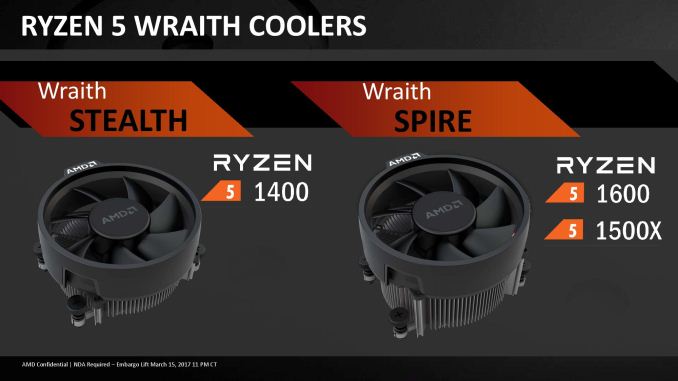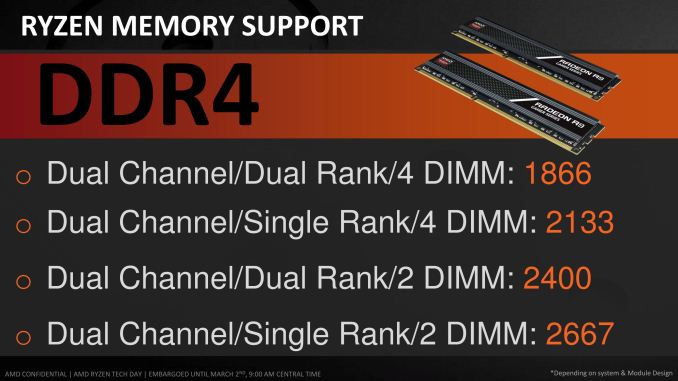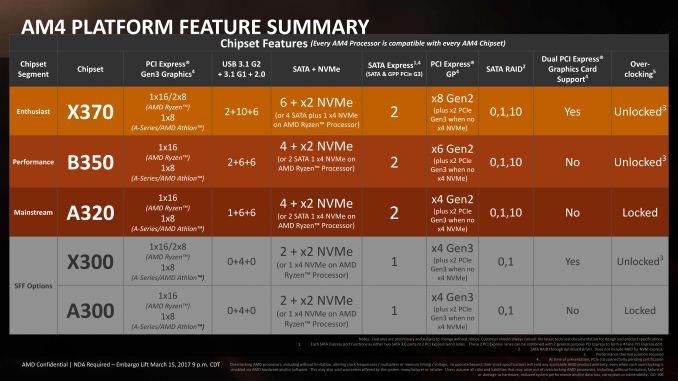The AMD Ryzen 5 1600X vs Core i5 Review: Twelve Threads vs Four at $250
by Ian Cutress on April 11, 2017 9:00 AM EST
Since the announcement of AMD’s mid-range offerings, it was clear that Ryzen 5 is going to have some major advantages over its direct price competition. For $250, the top Ryzen 5 1600X gives six cores and twelve threads of AMD’s latest microarchitecture. For the same price from Intel with a Core i5, you get four cores and no extra threads. Even though the Intel Core i5 based on Kaby Lake will have an instructions-per-clock advantage, it’s a hard hill to climb when the competition has 50% more cores and 200% more threads. In this review, we take the Ryzen 5 1600X and see if it smashes the market wide open.
Ryzen 3, Ryzen 5, Ryzen 7 (...Ryzen 9?)
Today marks the retail availability of AMD’s Ryzen 5 line of desktop processors. As the name suggests, Ryzen 5 sits between Ryzen 7, which was launched in March 2017, and Ryzen 3, to be launched in Q2 2017. The launch of Ryzen 7 last month was a return to the high-performance market for AMD, with its new x86 microarchitecture and core design built on GlobalFoundries 14nm process offering equivalent performance to Intel’s high-end desktop (HEDT) parts for under half-the-cost. Ryzen 5 is a step below that HEDT market, aiming more at mainstream users on more reasonable budgets.
One of the throwbacks to the Ryzen 7 launch for AMD was that the competition in that space was invariably overpriced to begin with – having had no competition for so many years, Intel was able to dictate the price and performance ratios without losing market share. While Ryzen 7 came out fighting in that market, ultimately it was up against a two-generation old CPU design from Intel, and not the latest, due to the way that Intel staggers its design cycle between mainstream and high-end processors. Ryzen 5, on the other hand, is coming out against processors that Intel has launched this year, on their leading design.
So while Ryzen 7 undercut the HEDT market by offering the same performance (in most cases) for half the price, Ryzen 5 can’t do the same. The midstream market is more price sensitive, and as a result AMD is launching Ryzen 5 at similar price points to Intel in this field. So while AMD can’t compete on price, it tackles the midstream market with more cores and more threads instead. Where Intel offers four cores, AMD offers six. Where Intel offers four threads, AMD offers twelve. This has implications for performance and power, which will be a part of this review.
(I'm joking about Ryzen 9 in the title to this section. No Ryzen 9 has been announced.)
The Ryzen Series
Without further ado, here is where the Ryzen families stand:
| AMD Ryzen 7 SKUs | |||||||
| Cores/ Threads |
Base/ Turbo |
XFR | L3 | TDP | Cost | Cooler | |
| Ryzen 7 1800X | 8/16 | 3.6/4.0 | +100 | 16 MB | 95 W | $499 | - |
| Ryzen 7 1700X | 8/16 | 3.4/3.8 | +100 | 16 MB | 95 W | $399 | - |
| Ryzen 7 1700 | 8/16 | 3.0/3.7 | +50 | 16 MB | 65 W | $329 | Spire RGB |
| AMD Ryzen 5 SKUs | |||||||
| Cores/ Threads |
Base/ Turbo |
XFR | L3 | TDP | Cost | Cooler | |
| Ryzen 5 1600X | 6/12 | 3.6/4.0 | +100 | 16 MB | 95 W | $249 | - |
| Ryzen 5 1600 | 6/12 | 3.2/3.6 | +100 | 16 MB | 65 W | $219 | Spire |
| Ryzen 5 1500X | 4/8 | 3.5/3.7 | +200 | 16 MB | 65 W | $189 | Spire |
| Ryzen 5 1400 | 4/8 | 3.2/3.4 | +50 | 8 MB | 65 W | $169 | Stealth |
Normally we see parts with with fewer cores having a higher clock frequency, however perhaps due to the voltage scaling of the design, we see a matched Ryzen 5 1600X in frequency to the Ryzen 7 1800X, but the rest of the Ryzen 5 family are offered at a lower TDP instead.
All the Ryzen 5 parts are unlocked, similar to the Ryzen 7 parts, and all four exhibit some movement in their ‘Extreme Frequency Range’ (XFR) mode, with the 1500X offering +200 MHz when there is sufficient cooling at hand.. AMD is going to offer some of these SKUs with their redesigned Wraith coolers, except the 1600X.
It is worth noting that the Wraith Spire for Ryzen 5 will not have RGB lighting, whereas the Wraith Spire for Ryzen 7 does use an RGB ring. OEMs will be able to use the higher-end Wraith Max stock cooler for their pre-built systems. AMD stated that at present, there are no plans to bring the Wraith coolers to retail as individual units, however they will keep track of how many users want them as individual items and regularly approach the issue internally.
To clarify some initial confusion, AMD has given me official TDP support numbers for the coolers. The entry level Wraith Stealth is 65W, the Wraith Spire is 65W for high-ambient conditions (AMD states this might be considered an '80W' design in low-ambient), and the Wraith Max is 95W for OEM builds using Ryzen 7 95W parts.
All the Ryzen 5 parts will support DDR4 ECC and non-ECC memory, and the memory support is the same as Ryzen 7, and will depend on how many modules and the types of modules being used. Recently companies like ADATA announced official support for AM4, as some users have found that there were memory growing pains when Ryzen 7 was launched.
Platform support for Ryzen 5, relating to PCIe lanes and chipset configurations, is identical to Ryzen 7. Each CPU offers sixteen PCIe 3.0 lanes for graphics, along with four lanes for a chipset and four lanes for storage. Chipsets can then offer up to eight PCIe 2.0 lanes which can bifurcated up to x4 (AMD GPUs can use chipset lanes for graphics as well, however at reduced bandwidth and additional latency).
Competition
The high-end Ryzen 5 1600X, at $249, is a shoe-in to compete against Intel’s i5-7600K at $242. Intel’s CPU is based on the Kaby Lake microarchitecture, and we’ve already shown in the Ryzen 7 review that by comparison Ryzen is more circa Broadwell, which is two generations behind. AMD won’t win much when it comes to single-threaded tests here, but the multi-threaded situation is where AMD shines.
| Comparison: Ryzen 5 1600X vs Core i5-7600K | ||
| AMD Ryzen 5 1600X |
Features | Intel Core i5-7600K |
| 6 / 12 | Cores/Threads | 4 / 4 |
| 3.6 / 4.0 GHz | Base/Turbo | 3.8 / 4.2 GHz |
| 16 | PCIe 3.0 Lanes | 16 |
| 16 MB | L3 Cache | 6 MB |
| 95 W | TDP | 91 W |
| $249 | Price (MSRP) | $242 |
Here we have twelve threads against four, at a 95W TDP compared to a 91W TDP (the 1600 is 65W, which looks better on paper). It is expected that for situations where a compute workload can scale across cores and threads that the AMD chip will wipe the floor with the competition. For more generic office workloads, it will interesting to see where the marks fall.
On the quad-core parts, there are several competitive points to choose from. The AMD Ryzen 5 1500X, at $189, sits near Intel’s Core i5-7500 at $192. This would be a shootout of a base quad-core in the Core i5 versus a quad-core with hyperthreading.
| Comparison: Ryzen 5 1500X vs Core i5-7500 | ||
| AMD Ryzen 5 1500X |
Features | Intel Core i5-7500 |
| 4 / 8 | Cores/Threads | 4 / 4 |
| 3.5 / 3.7 GHz | Base/Turbo | 3.4 / 3.8 GHz |
| 16 | PCIe 3.0 Lanes | 16 |
| 16 MB | L3 Cache | 6 MB |
| 65 W | TDP | 65 W |
| $189 | Price (MSRP) | $182 |
The reason why I didn’t pull out the Core i3-7350K there, at $168, is because the performance of the 7350K sits near the Pentium G4560, which is only $64 (and the subject of an upcoming review). That all being said, the $168 price of the i3-7350K matches up to the $169 price of the Ryzen 5 1400, although the 1400 has double the cores and double the threads of the 7350K.
Chipsets for Ryzen 5
The chipsets for AMD’s AM4 CPUs come in three main forms: the high-end X370 designed for premium Ryzen 7 systems and multi-GPU gaming (or multi-PCIe card workstations), mid-range B350 motherboards that still support overclocking but are more targeted at Ryzen 5 systems with a single graphics card, and the more budget range A320 which does not have overclocking and will be a fit in for Ryzen 3 later this year.
We are now at a point where the motherboard manufacturers are swimming in AMD motherboards, and distributors are building stock of various models. For Ryzen 5, AMD is pitching the B350 chipset based motherboards as a suitable solution, especially when compared to Intel’s B250 motherboards for Kaby Lake processors.
The B350 configuration matches that on the X370, save for a couple of PCIe lanes from the chipset and the focus on a single GPU.















254 Comments
View All Comments
SkipPerk - Wednesday, May 3, 2017 - link
These are low-end CPU's. People use those for gaming and web-surfing. I have a proper Xeon machine at work like a normal person. Not to mention, you reference video software. What tiny percentage of computer users ever own or use video software? That is a tiny industry. It reminds me of the silly youtube reviews where the reviewer assumes everyone is editing videos, when less than one percent of us will ever do so.Most people buying non-Xeon CPU's really will be using basic software (MS Office, WinZip,...) or games. The only time I have used non-Xeon CPU's for work was when I had software that loved clock speed. Then I got a bunch of 6-core's and overclocked them (it was funny to watch the guys at Microcenter as I bought ten $1k CPUs and cheesy AIO water coolers). Otherwise one uses the right tool for the job.
AndrewJacksonZA - Tuesday, April 11, 2017 - link
On the last page, "On The Benchmark Results""Looking at the results, it’s hard to notice the effect that 12 threads has on multithreaded CPU tests."
Don't you mean that it's NOT hard to notice?
Drumsticks - Tuesday, April 11, 2017 - link
I didn't see the 7600k in gaming benchmarks, was that a mistake/not ready, or is it on purpose?Thanks for the review guys! This new benchmark suite looks phenomenal!
mmegibb - Tuesday, April 11, 2017 - link
I was disappointed not to see the i5-7600k in the gaming benchmarks. Perhaps it wouldn't be much different than the i5-7600, but I have sometimes seen a difference. For my next build, it's looking like it's between the 1600x and the 7600k.fanofanand - Tuesday, April 11, 2017 - link
"Platform wise, the Intel side can offer more features on Z270 over AM4"Aside from Optane support, what does Z270 offer that AM4 doesn't?
MajGenRelativity - Tuesday, April 11, 2017 - link
Z270 has more PCIe lanes off the chipset for controllers and such that AM4 does notfanofanand - Tuesday, April 11, 2017 - link
I won't disagree with that, but I'm not sure a few extra pci-e lanes is considered a feature. Features are typically something like M.2 support, built-in wifi, things like that. The extra pci-e lanes allows for MORE connected devices, but is a few extra pci-e lanes really considered a feature anymore? With Optane being worthless for 99.99999% of consumers, I'm just not seeing where Z270 gives more for the extra money.JasonMZW20 - Tuesday, April 11, 2017 - link
Let's do a rundown:Ryzen + X370
20 (3.0) + 8 (2.0)
Platform usable total: 28
Core i7 + Z270
16 + 14 (all 3.0)
Platform usable total: 30
Intel's Z270 spec sheet is a little disingenuous, as yes it does have a maximum of 24 lanes, but 10 are reserved for actual features like SATA and USB 2.0/3.x. 14 can be used by a consumer, giving you a total of 2 NVMe x4 + 1 NVMe x2 leaving x4 for other things like actual PCIe slots. That 3rd NVMe slot may share PCIe lanes with a PCIe add-in slot, if configured that way.
Ryzen PCIe config (20 lanes): 1x16, 2x8 for graphics and x4 NVMe (or x2 SATA when NVMe is not used)
Core i7 config (16 lanes): 1x16, 2x8, or 1x8+2x4 for graphics
They're actually pretty comparable.
mat9v - Tuesday, April 11, 2017 - link
No, not more PCIEx lines, those from chipset are virtual, they all go to CPU through DMI bus that is equivalent to (at best) 4 lines of PCIEx 3.0. All those chips (Intel and AMD) offer 16 lines from CPU for graphic card, but Zen also offers 4 lines for NVMe. Chipsets are connected by DMI (in Intel) and 4 lines of PCIEx 3.0 (in AMD), so that is equal, now Intel from those DMI lines offer virtual 24 lines of PCIEx 3.0 (a laugh and half) while AMD quite correctly offers 8 lines of PCIEx 2.0 (equivalent to 4 lines of PCIEx 3.0).psychobriggsy - Wednesday, April 12, 2017 - link
Indeed. If a user is going to need more than that, they're more likely going to be plumping for a HEDT system anyway. AMD's solution is coming in a bit, but that should be able to ramp up the IO significantly.